Comments / Questions (352)
![]() Nicole wrote:
Nicole wrote:
Hallo, ich bin ja leider grad schon am Anfang überfordert... 🙈 1. Nach der luftmasche reihe, steht in die 4. Lm ein Stäbchen, dahinter was von 3 Lm und 1 Stäbchen, heißt dass ich muss noch mal drei Lm extra häkeln? Und 2. Was heißt eine Lm überspringen, heißt dass nun dass ich die komplett auslasse oder eine Lm mache und dann eben erst ins nächste ein Stäbchen... ? Danke schon mal für eine Antwort! 😅
08.06.2018 - 21:11DROPS Design answered:
Liebe Nicole, häkeln Sie die genaue LM-Anzahl für Ihre Größe und dann das erste Stb in diei 4. Lm von der Nadel (= die 3 ersten Lm ersetzen das 1. Stb, so daß Sie insgesamt 2 Stb schon haben). Man überspringt in der ersten R in regelmäßigen Abständen 1 Lm, damit der Rand nicht zu stramm und eng wird und elastisch bleibt. Viel Spaß beim häkeln!
11.06.2018 - 08:21Heather Dunlop wrote:
Heartbroken. Finished the front only to discover the rest is in symbols which I have no idea how to follow. I could weep. Such a waste of yarn. 😢
07.06.2018 - 18:47DROPS Design answered:
Dear Mrs Dunlop, you will find videos showing how to work diagrams A.1, A.2, A.3 and A.5. They will help you to understand how to work diagrams. For any further individual assistance with diagrams you are welcome to contact the store where you bought your yarn, even per mail, telephone or via social medias. Happy crocheting!
08.06.2018 - 08:35
![]() Geertje wrote:
Geertje wrote:
Klopt het dat de onderkant wijder wordt als ik de foto bekijk is het aangesloten
31.05.2018 - 20:54DROPS Design answered:
Hallo Geertje, Dat klopt inderdaad; het is een iets getailleerd model die aan die aan de onderkant wat wijder wordt.
03.06.2018 - 20:17
![]() Coutarel wrote:
Coutarel wrote:
Pour la taille M comment terminer le rang A3 A on fait simplement A3 A pas A3 B comment terminer le rang puisque j'ai fais des mailles coulées faut il crocheter sur les mailles coulées? merci pour votre réponse
24.05.2018 - 18:48DROPS Design answered:
Bonjour Mme Coutarel, au début du tour, vous remplacez la 1ère bride par 3 ml (le 1er A.3A commence ainsi dans le 1er arceau du tour par 3 ml (= 1bride), 2 ml, 1bride. À la fin du tour, crochetez 1 ml, 1 mc dans la 3ème ml du début du tour. Bon crochet!
25.05.2018 - 08:38
![]() Nadine wrote:
Nadine wrote:
Oh ich meinte XL
11.05.2018 - 15:13
![]() Nadine wrote:
Nadine wrote:
Ich habe dieses Top in XXL angefangen, habe aber unter der Brust 22cm zu viel. Bei der Maschenprobe habe ich 16Stb für 10cm. Und dennoch habe ich bei 196M viel zu viel. Ich bin langsam frustriert, habe es vier mal neu angefangen.
11.05.2018 - 14:57DROPS Design answered:
Liebe Nadine, diese 196 M sind für das ganze Umfang, Vorderteil wird dann nur über die ersten 98 Maschen gehäkelt. Viel Spaß beim häkeln!
11.05.2018 - 16:05
![]() Eura Tromboni wrote:
Eura Tromboni wrote:
Buongiorno vorrei sapere come si lavora il secondo triangolo della parte dietro, non riesco a capire cosa vuol dire: si lavora nella stessa riga della maglia alta del davanti, mi potete aiutare? Grazie. \\\\r\\\\nEura Tromboni
28.04.2018 - 17:34DROPS Design answered:
Buonasera Eura. Quando lavora il davanti, avvia le catenelle e dopo la prima riga ha un certo numero di maglie alte. Prosegue poi solo sulla prima metà di queste maglie. Il secondo triangolo del dietro viene lavorato sulla metà delle maglie non lavorate per il davanti, saltando le maglie che servono per gli scalfi. Buon lavoro!
28.04.2018 - 21:32
![]() Francien Bosma wrote:
Francien Bosma wrote:
Vraag over A1..... Er staat haak 33 lossen. Vervolgens in de 2e losse een vasten. Dan 3 vasten in de vokgende lossen..... Dan 1 losse overslaan, weer 5 lossen enz. Volgens mij kom je dan niet op 28 vasten uit op het laatst??? Wat doe ik fout??
16.04.2018 - 14:24DROPS Design answered:
Hallo Francien, Nadat je de 33 lossen hebt gehaakt, sla je 1 losse over en haak je eerst 4 vasten, dan herhaal je 4 keer: 1 vaste overslaan en 5 vasten in elk van de volgende lossen = 20 vasten en tot slot 1 losse overslaan en 3 vasten. Hierdoor kom je op een totaal van 28 vasten, want de eerste losse om mee te keren wordt ook meegerekend. Deze zie je in het telpatroon ook als verticaal streepje staan.
21.04.2018 - 13:35
![]() Christine Engelund wrote:
Christine Engelund wrote:
Hej Jeg tror antallet af A.3B er forkert for medium. Der står nul, men denne burde være 1, da der ellers mangler 3 masker. Jeg mangler i hvert fald tre, og jeg har tjekket flere gange at jeg ikke har lavet nogen fejl, så noget er galt.
09.04.2018 - 22:44
![]() Dineke wrote:
Dineke wrote:
In patroon deel A.2 spreekt men van een "stokje om stokje". (4e toer). ik ken wel een relief-stokje maar dat is volgens mij niet hetgeen wat jullie bedoelen, want er zijn in die toer geen stokjes waar men om heen moet haken.
31.03.2018 - 15:59DROPS Design answered:
Hallo Dineke, Er wordt bedoeld: stokje om de steek. (stk= stokje en st= steek). Dus je haakt in dit geval om de lossen heen.
02.04.2018 - 10:23
Aphrodite#aphroditetop |
|||||||||||||||||||||||||||||||||||||||||||
 |
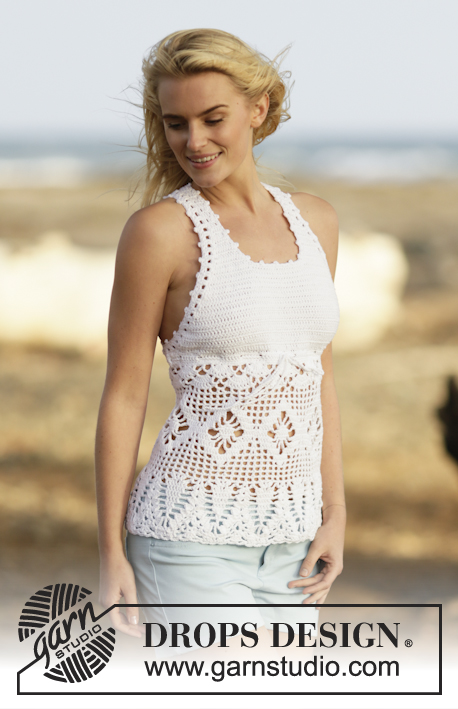 |
||||||||||||||||||||||||||||||||||||||||||
Crochet DROPS top with fans and star pattern in ”Cotton Light”. Size: S - XXXL.
DROPS 162-1 |
|||||||||||||||||||||||||||||||||||||||||||
|
PATTERN: See diagrams A.1 to A.5. CROCHET INFO: Replace first tr at beg of every tr row/round with 3 ch. Finish a round with tr with 1 sl st in 3rd ch. Replace first dc at beg of every dc row/round with 1 ch. Finish a round with 1 sl st in ch from beg of round. Replace first triple tr at beg on round with 5 ch. Finish a round with 1 sl st in 5th ch DECREASE TIP: Dec 1 tr by working 2 tr tog as follows: Work 1 tr but wait with last pull through (= 2 sts on hook), then work next tr but on last pull through, pull yarn through all 3 sts on hook. ---------------------------------------------------------- TOP: Worked in several parts. First work front piece, then 2 triangles that are put tog for back piece, then work the body downwards. FRONT PIECE: Work 175-194-213-237-266-295 ch on hook size 3.5 mm with Cotton Light. Turn and work 1 tr in fourth ch from hook (= 2 tr), * skip 1 ch, 1 tr in each of the next 5 ch *, repeat from *-* and finish by skipping 1 ch, 1 tr in each of the last 2-3-4-4-3-2 ch = 144-160-176-196-220-244 tr. Turn piece. Front piece is now worked back and forth over the first 72-80-88-98-110-122 tr on row. READ CROCHET INFO! Work 1 tr in every tr AT THE SAME TIME dec 1 tr in each side on every row - READ DECREASE TIP. Dec 16-18-19-21-22-24 times in total in each side = 40-44-50-56-66-74 tr, piece now measures approx. 17-19-20-22-23-25 cm. Now work only over the first 10-11-13-15-19-22 tr on row (= from RS) as follows: Work 1 tr in every tr while AT THE SAME TIME dec 1 tr in each side of piece = 8-9-11-13-17-20 tr. Work 1 row more the same way = 6-7-9-11-15-18 tr. Then work 1 tr in every tr, the dec towards mid front is now done, but continue to dec 1 st in the side (towards armhole) on every row 2-3-5-7-11-14 more times = 4 tr remain on strap in all sizes. Continue with 1 tr in every tr until piece measures 40-44-48-52-56-60 cm from ch-row. Fasten off. Repeat in the opposite side but now work over the last 10-11-13-15-19-22 tr on row. The 20-22-24-26-28-30 tr in the middle of piece not worked = neck. BACK PIECE: Back piece consists of two triangles that are sewn tog. TRIANGLE 1 (top part of back): Work 33 ch on hook size 3.5 mm with Cotton Light. Turn and work 1 dc in second ch from hook (= 2 dc), work 1 dc in each of the next 3 ch, * skip 1 ch, 1 dc in each of the next 5 ch *, repeat from *-* and finish by skipping 1 ch, 1 dc in each of the last 3 ch = 28 dc. Turn and work according to A.1. Cut the yarn when triangle is done and put it aside. TRIANGLE 2: This is worked in the same tr-row as front piece. Skip 22-26-30-35-41-47 tr (= armhole) after last tr on front piece. Work 1 dc in each of the next 28 tr, turn and work back and forth according to A.1 (22-26-30-35-41-47 tr remain on row after A.1 = armhole). When this triangle is done, sew them tog in the tip. BODY: Worked top down, on underside of ch-row from front and back piece. First work back and forth, then work in the round. From RS: Beg in first ch, work 3 ch (= 1 tr), then work 1 tr in bottom edge of every tr from tr-row = 144-160-176-196-220-244 tr. ROW 1 (WS): Work 1 dc in every tr, AT THE SAME TIME adjust no of sts to 144-168-180-192-216-240 dc. ROW 2 (RS): Work A.2 A (= 6 sts), work A.2 B over the next 132-156-168-180-204-228 sts, work A.2 C (= 6 sts). Work A.2 back and forth one time vertically. On last row in A.2 work 1 sl st at beg of round, now work piece in the round. ROUND 1: Work sl st until 1st ch-loop and now work after A.3 A: Work as follows in every ch-space: 1 tr + 2 ch + 1 tr + 2 ch. In every tr-group work as follows: 1 tr in second tr, 2 ch, 1 tr in 4th tr, 2 ch, 1 tr in 6th tr, 2 ch, BUT 4-2-5-8-6-12 times evenly on round work according to A.3 B: Work as follows in every ch-space: 1 tr + 2 ch + 1 tr + 2 ch. In every tr-group work as follows: 1 tr in 2nd tr, 2 ch, 1 tr in 3rd tr, 2 ch, 1 tr in 5th tr, 2 ch, 1 tr in 6th tr, 2 ch (work 4 tr in fan instead of 3) = 64-72-80-88-96-112 tr with 2 sts between every tr. Finish round with 1 sl st in 3rd ch from beg of round. Then work according to A.4 (8-9-10-11-12-14 repetitions in width). Work A.4 1 time vertically, there are now 72-81-90-99-108-126 tr with 2 ch between every tr on round. Work a round with 1 tr + 2 ch in every tr, AT THE SAME TIME inc 0-3-0-3-0-0 tr evenly, inc by working 1 tr + 2 ch + 1 tr + 2 ch in a tr = 72-84-90-102-108-126 tr. Then work according to diagram A.5 (12-14-15-17-18-21 repetitions in width). Work diagram A.5 one time vertically. Fasten off. Piece now measures approx. 31 cm in all sizes from ch-row in waist and 63-65-67-69-71-73 cm in total. ASSEMBLY: Sew shoulder straps in each side on the top triangle on back piece (sew the 4 tr from shoulder strap against the 4 outermost dc in each side on triangle – NOTE! Try the top first and adjust length of straps if needed). CROCHET EDGE: Work an edge around the neck as follows: ROUND 1: Work 1 ch, 1 dc, * 1 ch, skip approx. 1 cm, 1 dc *, repeat from *-* and finish with 1 sl st in ch at beg of round – make sure to work a no of dc/ch that is divisible by 4. ROUND 2: Work 1 ch, * 1 dc in first dc, 3 ch, 1 sl st in same dc, work 1 dc in next ch, 1 dc in next dc, 1 dc in next ch *, repeat *-* and finish with 1 sl st in first ch on round. Fasten off. Work as follows around the armholes (make sure not to work the edge too loose): ARMHOLE WITHOUT VENT: ROUND 1: Work 1 ch, 1 dc, * 1 ch, skip approx. 1 cm, 1 dc *, repeat from *-* and finish with 1 sl st in ch at beg of round – make sure to work a no of dc/ch that is divisible by 4. ROUND 2: 3 ch ( = 1 tr), 1 tr in next dc, * 2 ch, skip 1 ch and 1 dc, 1 tr in next ch, 1 tr in next dc *, repeat from *-*, finish with 2 ch and 1 sl st in 3rd ch from beg of round. ROUND 3: 1 ch, work 1 dc in every tr and 2 dc in every ch-space, finish with 1 sl st in first ch. ROUND 4: Work 1 ch, * 1 dc in first dc, 3 ch, 1 sl st in same dc, work 1 dc in each of the next 3 dc *, repeat from *-* and finish with 1 sl st in first ch on round. Fasten off. ARMHOLE WITH VENT: ROW 1 (= from WS): Work 1 ch, 1 dc, * 1 ch, skip approx. 1 cm, 1 dc *, repeat from *-* – make sure to work a no of dc/ch that is divisible by 4 + 2. Turn. ROW 2: 3 ch ( = 1 tr), 1 tr in next dc, * 2 ch, skip 1 ch and 1 dc, 1 tr in next ch, 1 tr in next dc *, repeat from *-*. Turn. ROW 3: 1 ch, work 1 dc in every tr and 2 dc in every ch-space. Turn. ROW 4: Work 1 ch, * 1 dc in next dc, 3 ch, 1 sl st in same dc, work 1 dc in each of the next 3 dc *, repeat from *-* 1 dc in next dc, 3 ch, 1 sl st in same dc, 1 dc in next dc. Fasten off. Sew a button at the top of vent, button through first tr in opposite side. TIES: Cut 2 lengths of 3 metres each. Twine the strands tog until they resist, fold the string double so that it twines again. Make a knot at each end. Thread tie up and down in row with tr in waist. |
|||||||||||||||||||||||||||||||||||||||||||
Diagram explanations |
|||||||||||||||||||||||||||||||||||||||||||
|
|||||||||||||||||||||||||||||||||||||||||||
 |
|||||||||||||||||||||||||||||||||||||||||||
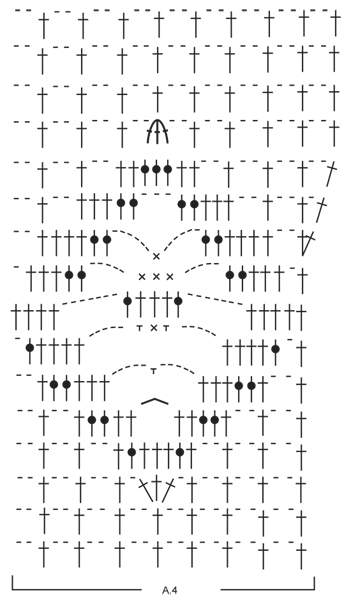 |
|||||||||||||||||||||||||||||||||||||||||||
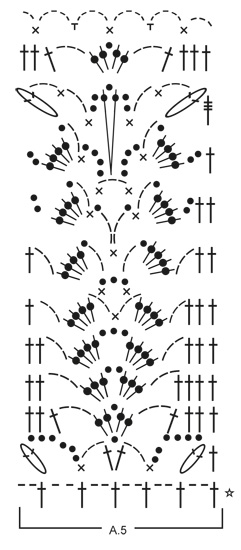 |
|||||||||||||||||||||||||||||||||||||||||||
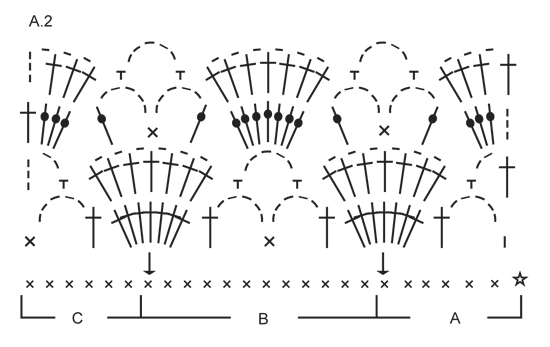 |
|||||||||||||||||||||||||||||||||||||||||||
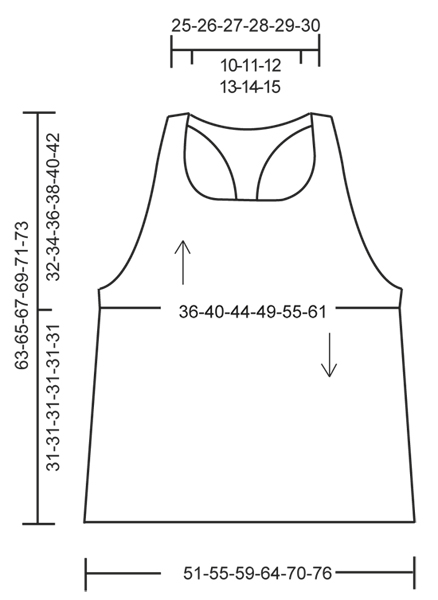 |
|||||||||||||||||||||||||||||||||||||||||||
Have you finished this pattern?Tag your pictures with #dropspattern #aphroditetop or submit them to the #dropsfan gallery. Do you need help with this pattern?You'll find 19 tutorial videos, a Comments/Questions area and more by visiting the pattern on garnstudio.com. © 1982-2025 DROPS Design A/S. We reserve all rights. This document, including all its sub-sections, has copyrights. Read more about what you can do with our patterns at the bottom of each pattern on our site. |
|||||||||||||||||||||||||||||||||||||||||||







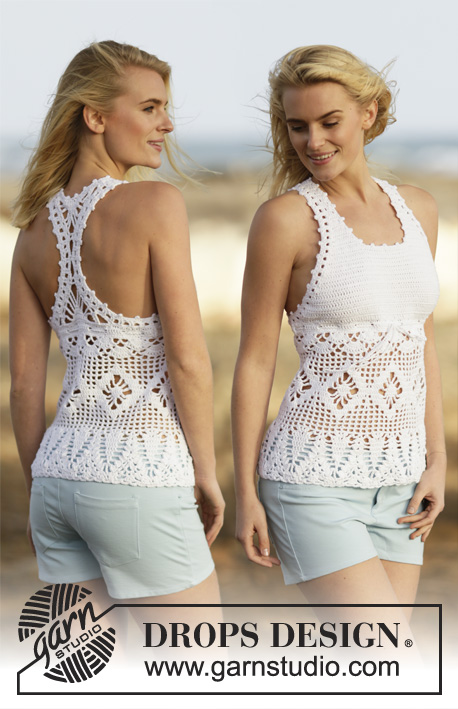
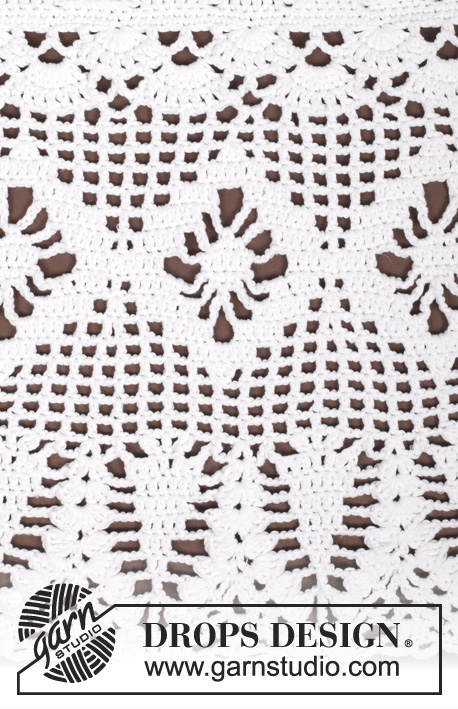

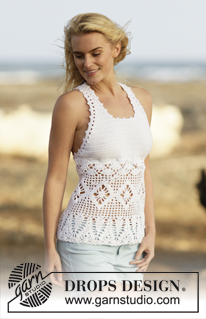
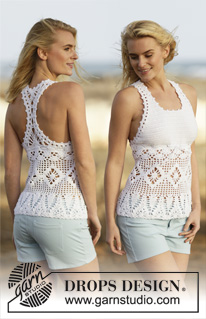











































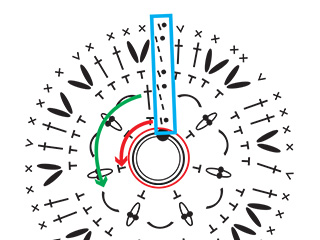





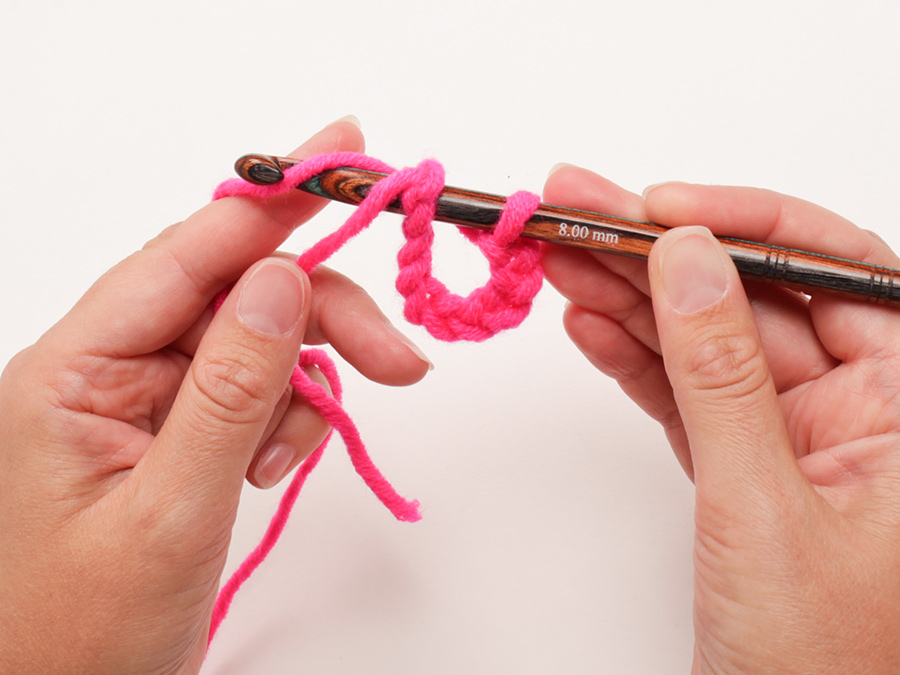

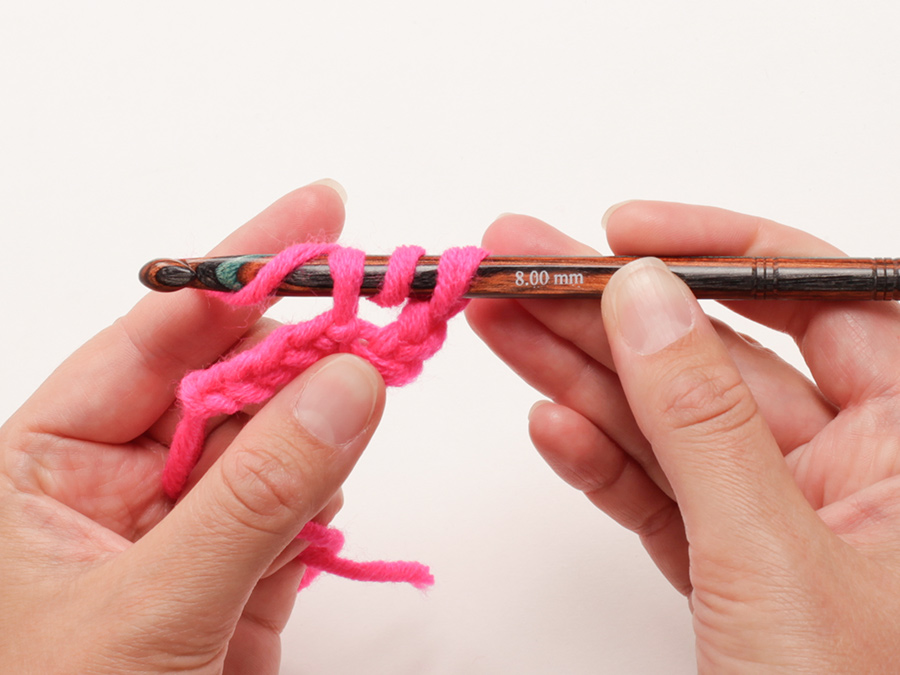







Post a comment to pattern DROPS 162-1
We would love to hear what you have to say about this pattern!
If you want to leave a question, please make sure you select the correct category in the form below, to speed up the answering process. Required fields are marked *.